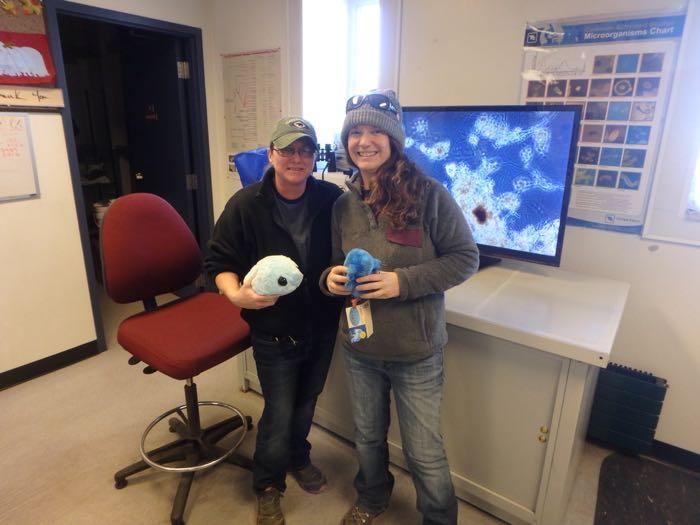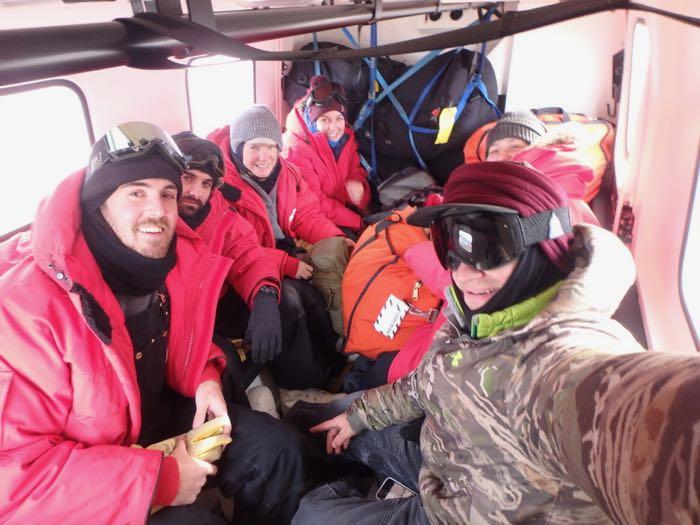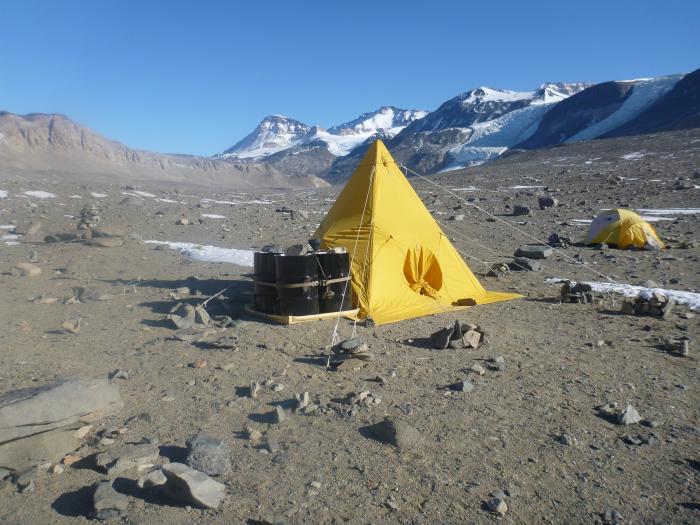"Who are the people in your neighborhood? The people that you meet each day"
-written by Jeff Moss performed by Muppets on Sesame Street
Yesterday morning my heart was fluttering! I was excited and nervous at the same time. I woke up at 5:00am on Saturday morning, pulled my clothes on and went to breakfast. Luckily, the galley opens up at 4:30am so I could easily go in and grab some oatmeal before setting up for my PolarConnect presentation!
As soon as I joined the Zoom session and saw all of the people there my heart began to pound! Wow, so many people joined in to see what is happening here in Antarctica! That's incredible! (If you missed it you can check out the PolarConnect presentation and question and answer session by clicking HERE. The familiar names on the list of people set me at ease and after the presentation was over I thought...wow, how lucky to have such an amazing community. Thank you so much!!!
 Amy Osborne getting ready for Sunday Funday! McMurdo Station, Antarctica
Amy Osborne getting ready for Sunday Funday! McMurdo Station, Antarctica
That's how I've felt being down here in Antarctica too! This is an incredible community of people working together to further global knowledge of Antarctica, the living things that call it home, and scientific research. I always feel like Sunday is community day around McMurdo station. A lot of people have the day off and there are always fun things going on including a delicious brunch, a tour of the Crary lab, restorative yoga, a visit to Scott Base, and Sunday science talk. I thought I'd take this Sunday to acknowledge some of the amazing people, outside of the research teams with whom I regularly interact and the divers, who I've met down here. This doesn't even come close to covering all of them, in fact it barely scratches the surface of the amazing folks down here who work long hours to make sure this place is a functioning supportive community. Let's dive in and meet a few of them...
 Amy Osborne and Bec Bragg, who works at the Waste Water Treatment facility, with stuffed water bears. McMurdo Station, Antarctica
Amy Osborne and Bec Bragg, who works at the Waste Water Treatment facility, with stuffed water bears. McMurdo Station, Antarctica
Bec Bragg works in the waste water treatment facility. All waste produced at McMurdo station has to leave the station and Bec is one of the people who makes sure that human waste leaves the continent in a safe way. She showed Graham, Aaron, and I how the waste is chopped up, called macerated, then processed even further separating out the solids. The solids, which look like fertilizer, will be shipped off the continent. The people at the facility make sure the water, that will go back into McMurdo sound, is as clean as possible. It was cool to learn about the water bears and the UV lights that help in this process. The water bears look pretty cute and do a really important job. (That's probably why there are so many stuffed ones hanging about) Thanks Bec for showing us around!!!
 These large aeration basins inside the waste water treatment facility, are where the small creatures like ciliates and bristle worms help breakdown the waste. McMurdo Station, Antarctica
These large aeration basins inside the waste water treatment facility, are where the small creatures like ciliates and bristle worms help breakdown the waste. McMurdo Station, Antarctica
 This water is ending the waste water treatment process. It has just passed through UV light. McMurdo Station, Antarctica
This water is ending the waste water treatment process. It has just passed through UV light. McMurdo Station, Antarctica
Al Berggren is the lead at the desalination plant. The whole station depends on water from the ocean being desalinated so we are able to drink it, take showers with it, and wash our clothes! Al, who has been working down here for 28 years, showed us the process of removing salt from the water and then making sure it's safe to drink. Thanks so much Al for sharing your knowledge with us!
 Al Berggren is a lead at the desalination facility. He is standing with a cut out section of a tube which holds a very thin membrane. These tubes help in the reverse osmosis process of desalination. McMurdo Station, Antarctica
Al Berggren is a lead at the desalination facility. He is standing with a cut out section of a tube which holds a very thin membrane. These tubes help in the reverse osmosis process of desalination. McMurdo Station, Antarctica
 These tubes contain very thin membranes that separate the salt from the water supporting the salilnation process. McMurdo Station, Antarctica
These tubes contain very thin membranes that separate the salt from the water supporting the salilnation process. McMurdo Station, Antarctica
Alicia Sutherland keeps people at McMurdo looking good. She gave me a fantastic and much needed haircut and provided a lot of cool conversation. When she's not in the land of ice and snow Alicia works as a hair sylist in Portland, Oregon. Check out this article to find out more about Alicia. She heard about jobs in Antarctica from a friend, came down here to check it out, and has been back 7 times!
 Alicia Sutherland and Amy Osborne after Amy's haircut. McMurdo Station, Antarctica
Alicia Sutherland and Amy Osborne after Amy's haircut. McMurdo Station, Antarctica
 Dr. Cissi Lin stands in front of the door to the room where the LiDAR technology is kept. McMurdo Station, Antarctica.
Dr. Cissi Lin stands in front of the door to the room where the LiDAR technology is kept. McMurdo Station, Antarctica.
Meet Cissi! Dr. Cissi Lin is one of the most cheerful and welcoming people I've met at McMurdo. She also works with lasers!!! Cissi does research with LiDAR (Light Detection and Ranging). She took us up to the LiDAR research spot at Arrival Heights and showed us how lasers are used to figure out temperature and wind speed in the upper atmosphere! I loved seeing the different colored lasers make their way across tables, bounce off of mirrors, and shoot up into the sky! To learn more about what LiDAR is doing in Antarctica click HERE Thanks Cissi!
 This table is a series of mirrors that are sending the yellow laser in a direction that will eventually send it straight up into the sky. Arrival Heights, Antarctica
This table is a series of mirrors that are sending the yellow laser in a direction that will eventually send it straight up into the sky. Arrival Heights, Antarctica
Speaking of friendly and cheerful, I had the opportunity to sit down and talk more with three guys who made me feel like I had an instant group of friends here. Mike Hatgistavrou, Nick Bakkedahl, and Dave Meyers are carpenters, known around McMurdo as "the carps". It's the first year down here for all of them and their stokedness permeates everything they do. They are smiling, friendly, and really outgoing folks who seem to always be having fun while working hard. The other day I decided to find out more about how they ended up here and what they love about this place.
 Nick Bakkedahl, Mike Hatgistavrou, Amy Osborne, a member of Point Blue Conservation Science, Denise Hardoy, and Dave Meyers in the back of Hagglund during sea ice training.
Nick Bakkedahl, Mike Hatgistavrou, Amy Osborne, a member of Point Blue Conservation Science, Denise Hardoy, and Dave Meyers in the back of Hagglund during sea ice training.
Hailing from three different parts of the United States (Nick is from L.A., Dave is from Montana, and Mike is from Long Island), all three of these guys love to be outdoors doing things like snowboarding, climbing, and hiking. In their jobs down here as carpenters they spend a lot of time doing work outside supporting different research projects. As Mike says, "we are like multi-tools always doing different things that involve different skills." Each day provides an opportunity to interact with and learn from different researchers. They all heard about jobs in Antarctica through people they know.
 Dave Meyers draws a profile of a crack in the ice based on the measurements our team took during sea ice training. McMurdo Sound, Antarctica
Dave Meyers draws a profile of a crack in the ice based on the measurements our team took during sea ice training. McMurdo Sound, Antarctica
All three agree that talking to so many different people and having access to the research going on here is one of the best things about working in Antarctica. "It's crazy when you step back and realize what you are a part of," says Nick. Dave agrees, "I have a chance to see and hear what's happening and realize my role in the big picture and how I'm helping...yeah, I'm building an outhouse for the National Science Foundation!" They all agree that going out in Pisten Bullys and checking out the sea ice is also a pretty cool part of the job.
 A scott tent in Dry Valleys, Antarctica. Photo by Lucy Coleman (PolarTREC 2014), Courtesy of ARCUS
A scott tent in Dry Valleys, Antarctica. Photo by Lucy Coleman (PolarTREC 2014), Courtesy of ARCUS
Mike and Dave both ended up the Dry Valleys setting up a field camp and were struck by a landscape unlike anything they'd ever seen. I haven't been to the Dry Valleys. Mike showed me a video of his time there and it is an incredible looking place! "Going somewhere scientists consider to be the closest on our planet that we have to Mars is pretty amazing," shares Mike. Similarly, Nick feels being a place where you can look around and not see anyone for miles is a pretty amazing part of being in Antarctica.
 View of Antarctica across the sea ice from Observation hill loop, McMurdo Station, Antarctica
View of Antarctica across the sea ice from Observation hill loop, McMurdo Station, Antarctica
I asked them all if they were involved in the scientific research side of things in Antarctica which project would they choose. "Glaciology and the age of ice," responded Dave. "I'd want to be a diver," said Nick. Mike's choice: Icefin. (I hope you made it to tonight's science talk Mike...it was from the Icefin team and was a fascinating talk about underwater robots and using Antarctica as a training ground to explore the oceans on other planets! Find out more about Icefin by clicking HERE)
 Icefin underwater robot. This can be sent far under the ice to explore and take measurements. McMurdo Station, Antarctica
Icefin underwater robot. This can be sent far under the ice to explore and take measurements. McMurdo Station, Antarctica
Thanks to Nick, Dave, and Mike for taking time to talk with me. I hope you get your hot cheetos and fresh veggies soon and to everyone at McMurdo who makes this a fantastic place to live, work, and explore.
 Amy Osborne and Nick Bakkedahl at a Sunday night science talk in the Galley at McMurdo Station, Antarctica
Amy Osborne and Nick Bakkedahl at a Sunday night science talk in the Galley at McMurdo Station, Antarctica

Add new comment